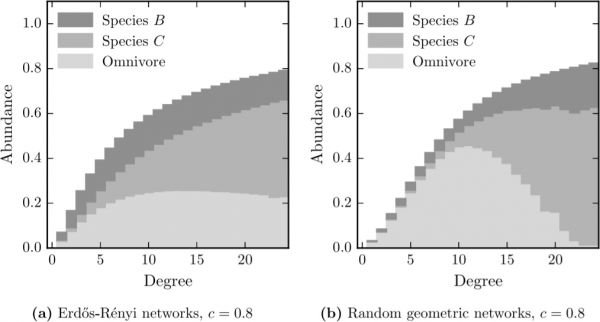barter2017spatial
Spatial effects in meta-foodwebs
Edmund Barter and Thilo Gross
Sci Rep 7, 9980, 2017
In ecology it is widely recognised that many landscapes comprise a network of discrete patches of habitat. The species that inhabit the patches interact with each other through a foodweb, the network of feeding interactions. The meta-foodweb model proposed by Pillai et al. combines the feeding relationships at each patch with the dispersal of species between patches, such that the whole system is represented by a network of networks. Previous work on meta-foodwebs has focussed on landscape networks that do not have an explicit spatial embedding, but in real landscapes the patches are usually distributed in space. Here we compare the dispersal of a meta-foodweb on \ER networks, that do not have a spatial embedding, and random geometric networks, that do have a spatial embedding. We found that local structure and large network distances in spatially embedded networks, lead to meso-scale patterns of patch occupation by both specialist and omnivorous species. In particular, we found that spatial separations make the coexistence of competing species more likely. Our results highlight the effects of spatial embeddings for meta-foodweb models, and the need for new analytical approaches to them.

Figure 1: The mean fraction of time patches of different degrees are occupied by each species. The bars are shaded in three sections, these show the fraction of time patches are occupied by: bottom) the omnivore, this can be with or without species B; middle) species C, which must also be with species B; and top) species B but neither species C or the omnivore. In the random geometric networks the intermediate degree patches have low abundance of species C, and high abundance of the omnivore.